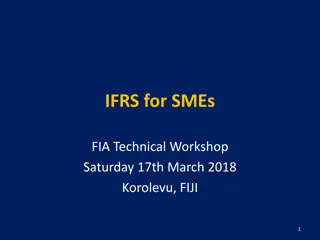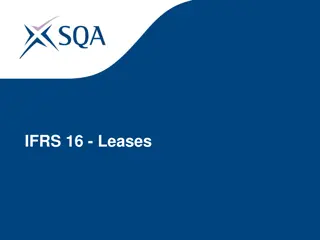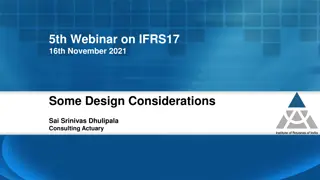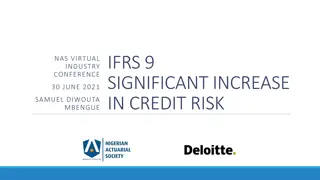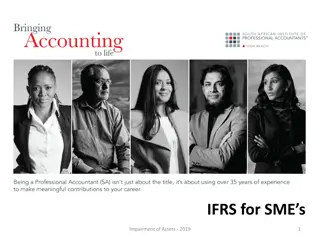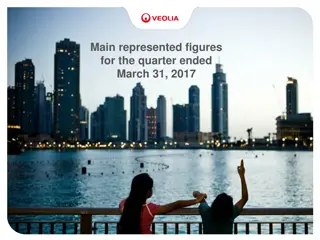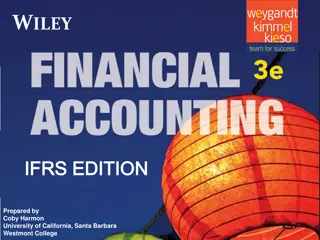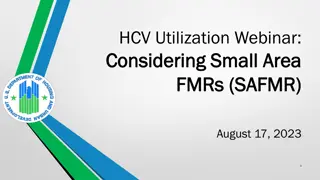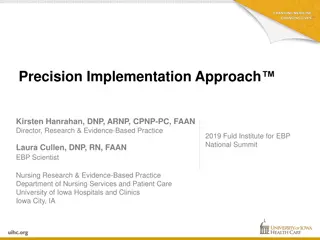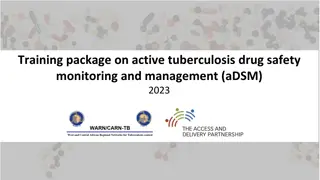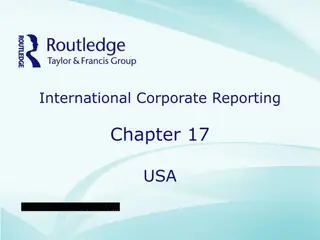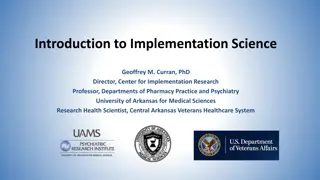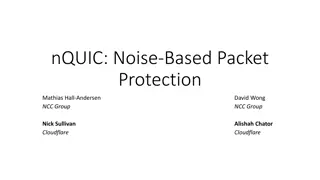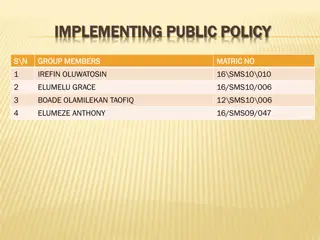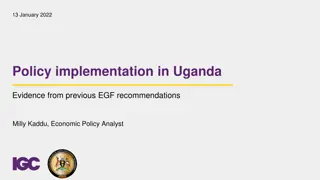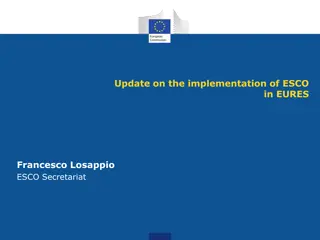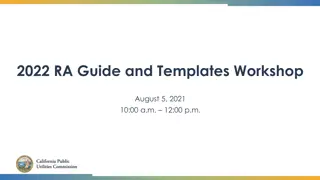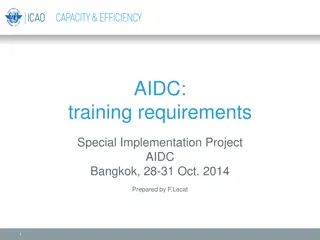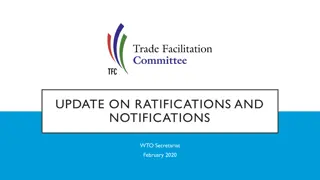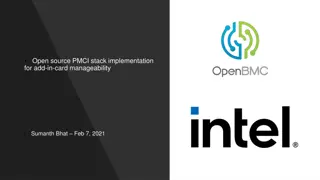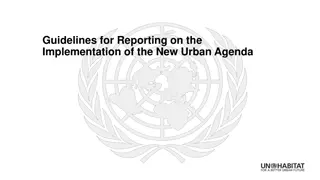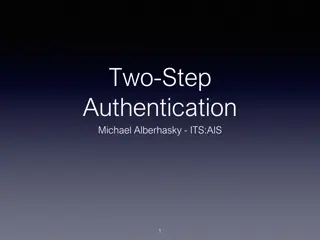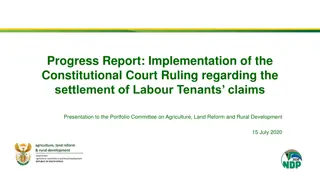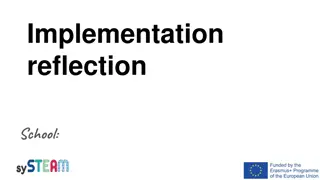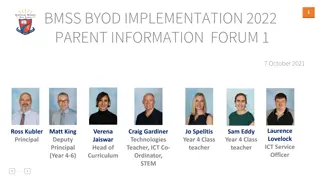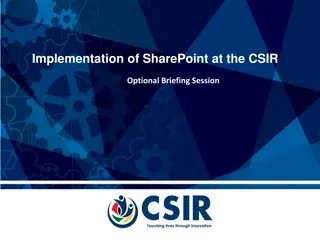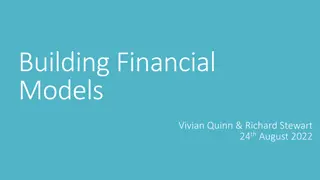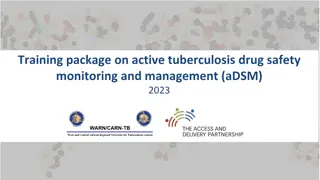Comprehensive Guide to IFRS 16 Implementation
Leases under IFRS 16 are recognized on the lessee's financial statement, with a single accounting model for most leases. There are exemptions for short-term leases and low-value assets. Lessor accounting remains largely unchanged from IAS 17, with new disclosure requirements. Effective from 1 April 2022 for periods starting on or after that date. The standard applies to all leases except specific excluded arrangements.
Download Presentation

Please find below an Image/Link to download the presentation.
The content on the website is provided AS IS for your information and personal use only. It may not be sold, licensed, or shared on other websites without obtaining consent from the author. Download presentation by click this link. If you encounter any issues during the download, it is possible that the publisher has removed the file from their server.
E N D
Presentation Transcript
IFRS 16 Implementation Guide Objectives The key objectives of the guide are to help users to understand: What IFRS 16 is and how it is different to IAS 17 Page 3 1 Accounting for leases under IFRS 16 as a lessee Page 9 2 Accounting for leases under IFRS 16 as a lessor Page 25 3 How the standard will impact the budgets Page 31 4 The implementation plan for the DHSC and for the group Page 37 5 What the practical challenges are Page 41 6 DHSC Leading the nation s health and care 2
Objectives of IFRS 16 To ensure that lessees and lessors provide relevant information in a manner that faithfully represents those transactions. This information gives a basis for users of financial statements to assess the effect that leases have on the financial performance of the reporting entity. IFRS 16 requires an entity to consider the terms and conditions of contracts and all relevant facts. To apply the standard consistently to contracts with similar characteristics and in similar circumstances. DHSC Leading the nation s health and care 4
Summary All leased assets are recognised on the lessee s Statement of Financial Position. Lessees have a single accounting model for all leases, except for the following exemptions: Short-term leases up to 12 months; and Where the underlying asset is of low value (< 5,000). Leasing of Intangible Assets DHSC Leading the nation s health and care 5
Summary contd Lessor accounting is substantially unchanged compared to IAS 17. Disclosure of new information about leases is required. A key risk is the completeness of identified leases. There will be a major impact on budgets. There will be an impact on many activities across organisations including: procurement; commercial; IT; and finance functions. Effective for periods beginning on or after 1 April 2022, with Ltd companies adopting from 1 April 2019. DHSC Leading the nation s health and care 6
Scope of the standard IFRS 16 applies to all leases and sub-lease arrangements except: IFRS 16 applicable? Leases to explore for or use natural resources Leases of biological assets within scope of IAS 41 Service concession arrangements within the scope of IFRIC 12 Licences of Intellectual Property granted by a lessor (IFRS 15) Rights held under licensing agreements within the scope of IAS 38 Leases of intangible assets (DHSC policy) DHSC Leading the nation s health and care 7
IFRS 16 overview The accounting treatment for leases, currently classified as operating leases, will change for lessees. IFRS 16 IAS 17 Right to use underlying leased asset Statement of financial position Statement of financial position Lease Assets XXX Lease Liabilities XXX Off balance sheet Obligation to make lease payments SOCNE SOCNE Depreciation XXX Lease payments XXX Finance cost XXX Net Expenditure XXX Net Expenditure XXX Depreciation on lease assets and finance cost of lease liability DHSC Leading the nation s health and care 8
Transition Upon transition to IFRS 16 the entities recognise the cumulative effect of initially applying the Standard as an adjustment to equity representing the difference between the asset and the liability. For leases previously classified as operating leases: Derived by: measuring the lease liability at the present value of the remaining lease payments; and discounting through use of the lessee s incremental borrowing rate at the date of initial application. Recognise a lease liability By taking: the amount equal to the lease liability; and adjusting by the amount of any prepaid or accrued lease payments relating to that lease. Recognise a right-of-use asset 10
Transition For leases previously classified as finance leases: lease liability The carrying amounts of the right-of-use asset and lease liability should remain the same as they were immediately before the date of initial application. right-of-use asset Fair Value Cap IAS 17 mandated that a finance lease was recognised at an amount equal to the fair value of the leased property or if lower the present value of the minimum lease payments. Such a cap no longer exists. 11
Steps to Identifying a lease Is there Is there an Identified asset? Right to control and direct the use of the asset throughout the period of use? Lease Explicitly or implicitly identified in the contract This judgment needs to be made at the inception of the arrangement (which may not include a formal, written contract). Right to obtain substantially all the economic benefits from use No substantive substitution rights Reassess only if the terms and conditions contract change. of the Right to direct the use of the asset throughout the period of use Physically distinct 12
Step 1: Identifying an Asset implicit / explicit An asset is typically identified by being explicitly specified in a contract. An asset can also be identified by being implicitly specified at the time that the asset is made available for use. Example 1 A Clinical Commissioning Group (CCG) (customer) enters into a contract with a local independent care home (supplier) to rent 50 care beds in single occupancy rooms and for provision of supplementary services, including full board and medical care provided by staff of the care home. The CCG has exclusive use of the single occupancy rooms throughout the period of the lease. The care home can use its wider capacity to meet the needs of the CCG however it chooses. This agreement contains an explicitly identified asset: single occupancy bedroom as well as implicitly identified asset: access to common areas. 13
Step 1: Substantive Substitution Rights Practical ability of lessor to substitute asset throughout the period of use? No Could be an identified asset Yes Lessor benefits economically from substitution? No Back to example 1: Yes Because the supplier can use its wider capacity as it chooses, the lessor benefits from substitution. No identified asset 14
Step 2: Right to Control Economic Benefits Does the lessee have substantially* all of the economic benefits Yes No Could be a lease No lease Back to example 1: * For example, by having an exclusive use of the asset throughout the period of the lease. Entities are expected to use their judgment here of what constitutes substantially . Because the CCG has exclusive use of the single occupancy rooms it has substantially all of the economic benefits. 15
Step 2: Right to direct use Examples given in the Standard to describe how rights to direct use are established Include: The right to change what type and amount of output the asset produces The right to change when the asset is used, or the output is produced The right to change whether the asset is used, or the output is produced The right to change where the asset is used, and the output is produced Back to example 1: There is an identified asset but the customer (CCG) doesn t have the right to change the purpose of how the rooms are used, or which rooms are used to meet the needs of the CCG. Therefore the contract does not contain a lease. 16
Measurement of the lease liability The lessee must recognise a lease liability on the commencement date of a lease, i.e. the date on which the lessor makes an underlying asset available for use by a lessee. The lease liability is made up of the present value of the following: Fixed payments from the commencement date Variable payments that depend on an index or a rate Residual value guarantees* Termination penalties** Exercise price of a purchase option** Lease Liability * If included in the contractual terms and conditions ** If lessee is reasonably certain to exercise the option 17
Measurement of the right-of-use asset The lessee must also recognise a right-of-use asset. This asset comprises: Payments made at or prior to commencement Initial Direct Costs Cost of removal and restoring Lease incentives received Lease Liability Right-of-Use Asset 18
Reassessment of the lease liability After commencement of the lease a lessee has to reassess the lease term upon occurrence of a significant event or a significant change in circumstances. Is it reasonably certain to exercise an option not previously included in the lease? Is it reasonably certain not to exercise an option previously included in the lease? Is it within the control of the lessee ? and or Examples: A significant leasehold improvement not anticipated at the commencement. A significant modification to the underlying asset (for example, removing a floor from the lease of the building). An inception of the sublease for a period beyond the term of the previously determined lease term. 19
Lease modifications Depending on the nature of the lease modification, the lessee may account for it as a separate lease. If it increases the scope of the lease by adding the right to use one or more underlying assets Separate Lease Where the lease modification is not a separate lease, the lessee is required to: the consideration for the lease increases by an amount commensurate with the stand- alone price for the increase in scope determine the term of the modified lease; remeasure the lease liability; and allocate payments to each lease component. 20
Lease term Periods covered by options to extend the lease* Periods covered by option to terminate the lease ** Non-cancellable periods * If the lessee is reasonably certain to exercise ** If the lessee is reasonably certain not to exercise Rent-freeperiod Reasonably certain Assessed at the commencement date. Consider all facts and circumstances that create an economic incentive, including any expected changes in facts and circumstances between the commencement date and until the exercise date. Commencement date 21
Lease payment components Variable lease payments that depend on index or rate Termination option penalties (4) Purchase option (2) (exercise price) Residual value guarantees (3) Fixed payments (1) (1) Including in-substance fixed payments. Note that there may be both lease and non-lease components that need to be separated or the practical expedient can be applied. (2) Include only if it is reasonably certain that the option will be exercised. (3) Lessees use the amounts they expect to pay. Lessors include any guarantee. (4) Include unless it is reasonably certain that the option will not be exercised. In-substance fixed payments are payments that may, in form, contain variability but that, in substance, are unavoidable. Variable lease payments that do not depend on an index or rate (e.g. based on usage or performance) are excluded from lease payments. 22
Discount rate the rate published by HMT in PES papers. The rate implicit in the lease. Lessee Cannot be determined? Then use: Where lessees cannot readily determine the interest rate implicit in the lease they are required to use the discount rate published by HMT, unless another discount rate more accurately represents their incremental borrowing rate. For most leases it is NOT expected that the lessee will be able to identify the interest rate implicit in the lease. 23
Lease and non-lease components Contracts may contain both a lease and non-lease component. The new standard requires lessees and lessors to separate the lease and non-lease components. Practical Expedient? Lease Lease components Non-lease components Lessees are required to separate the lease and non-lease components unless the practical expedient is applied. IFRS 16 permits lessees to account for all components of a lease as part of a lease arrangement. 24
Lessor Accounting Lessor accounting under IFRS 16 is predominantly carried forward from IAS 17. Does the lease transfer substantially all of the risks and rewards incidental to ownership of the underlying asset to the lessee? Yes No Finance Lease Operating Lease Lessors are required to provide the following disclosures: Selling profit or loss on finance leases. Finance income on the net investment in finance leases. Income relating to variable lease payments not included in the measurement of the net investment for finance leases. Lease income on operating leases, but separately disclosing variable lease payments that do not depend on an index or rate. 26
Lessor Accounting other considerations The practical expedient available to the lessees cannot be applied by the lessors and they have to separate lease and non-lease components. No practical expedient available Lease Assess under IFRS 15 Non-lease components Lease components Lessors are also required to use the rate implicit in the lease. They cannot use the incremental borrowing rate or rates published by the HM Treasury which are available to the lessees. the rate published by HMT in PES papers. The rate implicit in the lease the incremental borrowing rate. Lessor 27
Sale and leaseback Leaseback The seller-lessee measures the right of use asset at the proportion of the previous carrying amount that relates to the right of use asset retained by the seller-lessee. Asset Buyer - Lessor Seller - Lessee The buyer-lessor accounts for both the purchase, applying the appropriate standards, and the lease as a lessor arrangement per IFRS 16. Sale of the asset 28
Sublease An intermediate lessor must classify the sublease as a finance lease or an operating lease as follows: Lessor Head Lease If the head lease is a short-term lease that the entity, as a lessee, has accounted for by recognising the lease payments as an expense, the sublease must be classified as an operating lease. Intermediate Lessor Lessee Sublease Otherwise, the sublease must be classified by reference to the right-of-use asset arising from the head lease, rather than by reference to the economic useful life of the underlying asset Sublessee 29
Sublease - example An intermediate lessor enters into a five-year lease for 5,000 square metres of office space (the head lease) with Entity A (the head lessor). Yr. 1 Head Lessor Operating lease At the beginning of year three, the intermediate lessor sublets the 5,000 square metres of office space for the remaining three years of the head lease to a sublessee. Yr. 2 5,000 sqm Intermediate Lessor Assessment Yr. 3 Lessee From the intermediate lessor s perspective, at the time the sub-lease is entered into, the right-of-use asset has a remaining economic life of three years, and it is being sub-leased for the entirety of that period. As the sub- lease is for all of the remaining useful economic life of the right-of-use asset, the sub-lease is classified as a finance lease, even though three years is unlikely to be the full remaining useful economic life of the underlying property. 5,000 sqm Yr. 4 Sublessee Finance lease Yr. 5 30
Budgeting: Overview There will be a major impact on budgets. The guiding principle is that budgeting for leases will align to the accounting. Most leases will now be recognised on the Statement of Financial Position for budgetary purposes. IFRS 16 will have an impact on: Capital expenditure at lease commencement (asset recognition) and remeasurement Ring-fenced resource expenditure as a result of depreciation* Non-ring-fenced resource expenditure for interest * Non-ring-fenced for NHS providers 32
Budgeting: Transition to IFRS 16 On transition to IFRS 16, it is mandated that all FReM bodies retrospectively apply the standard with the cumulative effect recognised as an adjustment to opening balances (cumulative catch-up). No budget entry should be made for the cumulative catch-up adjustment to accounts. Instead, for budgeting, the cumulative catch-up is ignored and no Prior Period Adjustment (PPA) is required. Note On transition, in accounts, an asset and liability would be recognised. No corresponding budgeting entries should be made in the year of implementation. 33
Budgeting: Example New Lease The impact IFRS 16 will have on budgets can be demonstrated through an example. IFRS 16 IAS 17 Operating Lease 400,000 400,000 350,000 350,000 300,000 300,000 250,000 250,000 200,000 200,000 150,000 150,000 100,000 100,000 50,000 50,000 0 0 Yr 1 Yr 2 Yr 3 Yr 4 Yr 5 Yr 1 Yr 2 Yr 3 Yr 4 Yr 5 RDEL CDEL RDEL - Interest Ring-fenced RDEL - Depreciation Implication: CDEL requirement for new leases + RDEL is front-loaded 34
Budgeting impact of: Remeasurement of the lease liability Scores to CDEL to the extent the remeasurement impacts the value of the right-of-use asset Derecognition of the asset = credit to CDEL, subsequent recognition of the RoU = debit to CDEL. 5% of NBV or 20m rule applies (see CBG 7.2 and 7.3 for more details) Sale and leaseback Peppercorn leases Budgeting akin to donated assets. Debit and Credit score to CDEL, depreciation scores to AME. 35
Budgeting impact of: Derecognition of right-of-use asset will credit CDEL. The termination fee and any difference between the right-of-use asset value and the liability cleared will score to RDEL. Early termination of the lease Upward revaluation of the right-of-use asset goes through OCI and has no budget impact. Revaluation of the RoU asset An impairment should first utilize the revaluation reserve. It may have a budget impact (AME or DEL). (see CBG 3.49 to 3.52 for more details) Impairment of the RoU asset 36
Key milestones: Overview Continuing through 2021 Planning and identification of leases Late Autumn 2021 Be ready to forecast IFRS 16 transition impact on accounts Spring 2022 Discuss transition arrangements and implementation with audit prior to 2021/22 year end Late Spring 2022 Finalise IAS 8 disclosures in 2021/22 accounts Spring 2023 Finalise plans for 2022/23 accounts and agree with audit. April 2023 Accounts for 2022/23 with IFRS 16. 38
Group IFRS 16 high level implementation plan - timeline Auditors report any IFRS 16-related issues identified during the course of their 2021/22 financial audits Communicate & publish IFRS 16 group implementation plan To be confirmed: Deadline for an Agreed upon Procedures audit on data and completeness of data First data collection from component bodies Mar-22 May-22 Jun-22 Aug-22 Dec-22 Oct-22 Oct-21 Nov-22 Jan-22 Jul-22 Sep-22 Nov-21 Jan-23 Apr-22 Second data collection from component bodies Final data collection from component bodies Agree group implementation approach Consolidation schedules prepared 39
Practical Challenges: Overview IFRS 16 will increase the amount of fixed assets an organisation will need to maintain information regarding to inform valuation assessments for instance (revaluation or impairment) Additional cost of assets ownership Obtaining and assessing all of the relevant data. Completeness of the lease registers. Assets records will require greater level of detail. Completeness of data Separating lease and non-lease components, consideration of extension and termination options. Estimates and judgments 41
Practical Challenges: Overview Lack of symmetry between lessee and lessor accounting will require complex group adjustment on consolidation. Group consolidations and eliminations Lack of documentation in some cases will require judgments as to what existing arrangements represent and what accounting treatment is appropriate. Judgments around existing arrangements After the initial implementation the entities will have to continue maintaining control of the lease arrangements. Regular reassessment reviews etc. Lease Management 42
Practical Challenges: Addressing any issues There are many colleagues within the DHSC group as well as outside of it who can assist you with challenges and issues you come across when implementing the new Standard. Auditors Estates teams Finance Communication Contract owners National Bodies HM TACoE Treasury 43
NHS - specific issues There is usually an identified asset the void space. However, the CCG does not usually have the right to obtain the economic benefits from it it cannot rent it to someone else, it cannot use it for its own purposes, in some cases, the CCG does not even have access to the void space. On this basis, it is not a lease arrangement. However, need to consider whether any void space needs to be componentise as a non-lease part of a wider lease contract. Void space If a CCG has a contract to use a particular space/ room in a care home and can direct the use of that room and prevent it being used by other organisations then there may be a lease embedded in the arrangement. Continuing care contracts Usually in a managed service contract, there is an asset which is identified and not substitutable. It will be necessary to work out who has the rights to obtain substantially all of the assets and direct how and for what purpose the asset is to be used. If the asset is located in the Trust's buildings, has been calibrated to the Trust s specifications or is only used by the Trust then it is likely that the contract will contain a lease. Managed service contracts 44
Glossary Commencement date The date on which a lessor makes an underlying asset available for use by a lessee. Finance lease A lease that transfers substantially all the risks and rewards incidental to ownership of an underlying asset. Fixed payments Payments made by a lessee to a lessor for the right to use an underlying asset during the lease term, excluding variable payments. Initial direct costs Incremental costs of obtaining a lease that would not have been incurred if the lease had not been obtained, except for such costs incurred by a manufacturer or dealer lessor in connection with a finance lease. Interest rate implicit in the lease The rate of interest that causes the present value of (a) the lease payments and (b) the unguaranteed residual value to equal the sum of (i) the fair value of the underlying asset and (ii) any initial direct costs of the lessor. 45
Lease payments - Payments made by a lessee to a lessor relating to the right to use an underlying asset during the lease term, comprising the following: a) fixed payments (including in-substance fixed payments), less any lease incentives; b) variable lease payments that depend on an index or a rate; c) the exercise price of a purchase option if the lessee is reasonably certain to exercise that option; and d) payments of penalties for terminating the lease, if the lease term reflects the lessee exercising an option to terminate the lease. Glossary Lease Term - The non-cancellable period for which a lessee has the right to use an underlying asset, together with both: a) periods covered by an option to extend the lease if the lessee is reasonably certain to exercise that option; and b) periods covered by an option to terminate the lease if the lessee is reasonably certain not to exercise that option. Operating lease A lease that does not transfer substantially all the risks and rewards incidental to ownership of an underlying asset. Right-of-use asset An asset that represents a lessee s right to use an underlying asset for the lease term. 46
Glossary Short-term lease - A lease that, at the commencement date, has a lease term of 12 months or less. A lease that contains a purchase option is not a short-term lease. Sublease A transaction for which an underlying asset is re-leased be a lessee ( intermediate lessor ) to a third party, and the lease ( head lease ) between head lessor and lessee remains in effect. Underlying asset An asset that is the subject of a lease, for which the right to use that asset has been provided by a lessor to a lessee. Unguaranteed residual value That portion of the residual value of the underlying asset, the realisation of which by a lessor is not assured or is guaranteed solely by a party related to the lessor. Variable lease payments The portion of payments made by a lessee to a lessor for the right to use an underlying asset during the lease term that varies because of changes in facts or circumstances occurring after the commencement date, other than the passage of time. 47
Further Guidance Standard IFRS 16 Leases available of IAS Plus website DHSC Group Accounting Manual (GAM) 2021 to 2022 published May 2021 DHSC Group Accounting Manual IFRS 16 Supplement published October 2021 Financial Reporting Manual (FReM) 2021/22 published December 2020 Consolidated Budgeting Guidance (CBG) 2021 to 2022 published March 2021 HMT FReM IFRS 16 Leases Application Guidance published December 2020 HMT IFRS 16 Supplementary Budgeting Guidance published December 2020 NHS IFRS 16 implementation guide published by NHS England and Improvement 48


